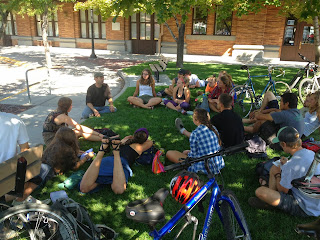A blog by Kelsey McMullen and Katie Kinney
The 2013-2014 Wilderness and Civilization class went to the
Bitterroot National Forest with our Forest Ecology professor, Andrew Larson.
There, we collected data on one hectare of forested land that has had strict
fire suppression since 1908. In the study, there are 9 plots in 3 different
national forests. We recorded data for the Bitterroot 4 plot, or B4, in Canyon
Creek, Bitterroot National Forest. The experiment, Age-Class Structure of Old
Growth Ponderosa Pine/Douglas-Fir Stands and Its Relationship to Fire History,
was conducted in 1993 by Stephen Arno, Joe H. Scott, and Michael G. Hartwell. The purpose of this study was to research the effects of
fires and fire suppression on Old Growth Ponderosa Pine (Pinus ponderosa)
stands. In this study, the focus in
particular was the age-class structure of the stands. The plot is approximately
100-m square, or one hectare. This plot was last measured in 1993.
 Fire suppression, instituted by the Forest
Service in the early 1900’s after the catastrophic 1910 fires, had a long term
effect on the growth of forests. Bitterroot 4, a plot that historically burned
every 13 years, has not experienced a fire since 1908. The result of this fire
suppression has caused significant growth in the understory that otherwise
would not be present with frequent fire. As mentioned in Andrew Larson’s
lecture, without a natural, regular fire regime in an old growth Ponderosa Pine
forest, the study plot would be a low severity fire regime, that being a plot
with old growth Ponderosa Pine and little understory growth, minimal variation
in species differentiation, and higher limb placement on the trees to protect
from the trees from the height of the fire. We saw firsthand that other species
we able to thrive without the process of regular fires. There was a notable
increase in other tree species growth compared to forests without fire
suppression as studied in our Forest Ecology class. This
includes growth of more fire intolerant and shade tolerant species, such as
Douglas-Fir (Pseudotsuga menziesii) and Grand Fir (Abies grandis), as well as
Lodgepole Pine (Pinus contorta) and Subalpine Fir (Abies lasiocarpa).
Understory shrubs were present in high densities as well, including
Kinnikinnick (Arctostaphylos uva-ursi), Thimbleberry (Rubus
parviflorus), Snowberry (Symphoricarpos), and Huckleberry (Vaccinuim). There were also large amounts of
coarse woody debris (CWD) as a result of infrequent fires to remove the dead
trees and logs. The result of the understory growth and CWD is competition for
nutrients, water, sunlight, and space, as well as a higher risk for a high
intensity and severity fire to strike the area.
Fire suppression, instituted by the Forest
Service in the early 1900’s after the catastrophic 1910 fires, had a long term
effect on the growth of forests. Bitterroot 4, a plot that historically burned
every 13 years, has not experienced a fire since 1908. The result of this fire
suppression has caused significant growth in the understory that otherwise
would not be present with frequent fire. As mentioned in Andrew Larson’s
lecture, without a natural, regular fire regime in an old growth Ponderosa Pine
forest, the study plot would be a low severity fire regime, that being a plot
with old growth Ponderosa Pine and little understory growth, minimal variation
in species differentiation, and higher limb placement on the trees to protect
from the trees from the height of the fire. We saw firsthand that other species
we able to thrive without the process of regular fires. There was a notable
increase in other tree species growth compared to forests without fire
suppression as studied in our Forest Ecology class. This
includes growth of more fire intolerant and shade tolerant species, such as
Douglas-Fir (Pseudotsuga menziesii) and Grand Fir (Abies grandis), as well as
Lodgepole Pine (Pinus contorta) and Subalpine Fir (Abies lasiocarpa).
Understory shrubs were present in high densities as well, including
Kinnikinnick (Arctostaphylos uva-ursi), Thimbleberry (Rubus
parviflorus), Snowberry (Symphoricarpos), and Huckleberry (Vaccinuim). There were also large amounts of
coarse woody debris (CWD) as a result of infrequent fires to remove the dead
trees and logs. The result of the understory growth and CWD is competition for
nutrients, water, sunlight, and space, as well as a higher risk for a high
intensity and severity fire to strike the area.
The study produced both a graph with the location of each
tree within the hectare and a chart of the data. The chart displayed the tree
species, tag number, diameter breast height, age (by core sample), and notable
conditions of tree (dead, alive, beetle kill). Using both the data on the chart
and the graph for reference, we were able to easily identify and locate each
tree. For quick reference on the chart, there was an abbreviation for each tree
species using the genus and species of each tree. For example, Ponderosa Pine
was POPI, Douglas Fir: PSME, the Grand Fir: ABGR, and lastly, Lodgepole Pine:
PICO.
We used a special loggers measuring tape which has
centimeters multiplied by 3.14, or pi, to measure the diameter of each tree. We
divided our group into 4 smaller groups and combed the site to record each
tagged tree. We did encounter challenges such as fallen tagged trees, which
required rolling logs over and some tags were completely consumed by the tree
which we could find on the graph but not on the ground.
After we collected the data, Andrew Larson
demonstrated how to collect core samples from a tree using his increment borer.
He explained that sampling a tree does not affect the health of a tree because
the sample is too small to do any serious damage.
While monitoring in B4, we also found signs of
wildlife. We saw many piles of bear scat, most likely black bear, as well as
the remains of a snowshoe hare, flickers, and hornets (which had a special
liking for Myles). One of the Ponderosa trees that we monitored had bear
scratches about breast height, and looked like they continued all
the way up
the tree. We predict that when the tree was younger, a bear came along and
climbed high onto its branches, and the claw scars were still visible. The hornets
and flickers both made homes in the dead snags around the site.



















